How To Calculate Conductivity Due To Concentration
The conductivity of a solution (k) is proportional to the amount of dissolved ions the solution contains. Electric current is carried by the dissolved positive and negative ions, and the more ions, the more electric current. In addition to the amount of ions in the solution, the type of ions also makes a difference in the conductivity of the solution. Strong electrolytes (highly dissolved) are better conductors. Ions with more than a single charge also carry more current.
Step 1:
Step 1:
Obtain the molar conductivity (a constant) for the dissolved chemical in the solution. Molar conductivity is the sum of the molar conductivity of the anion and cation added together. Note the anion has a negative conductivity value so the final result is really a difference in the molar conductivity of the two species. Molar conductivities are theoretical values based on the conductivity of an infinitelydiluted solution.
Step 2:
Step 2:
Determine the volume of your solution. This should be in liters. Note: the volume should be determined after adding the electrolyte.
Step 3:
Step 3:
Determine the molar quantity of your electrolyte (the molecular species that is added to the solvent). If you know how many grams of electrolyte have been added, divide that weight by the molecular weight of the electrolyte to get moles of electrolyte.
Step 4:
Step 4:
Determine the concentration of your solution. Concentration is given in moles per liter. Divide the number of moles obtained in Step 3 by the volume obtained in Step 2 to get the molar concentration of the solution.
Step 5:
Step 5:
Determine the conductance of your solution by multiplying the molar conductivity by the molar concentration. The result is k, conductivity of the solution.
Things Needed
- Molar conductivities for all ionic species
- Volume of the solution
- Weight in grams of the ionic species
- Molecular weight for each ionic species
- Alpha, or degree of dissociation, for weak electrolytes
TL;DR (Too Long; Didn't Read)
These are rough calculations for strong-electrolyte solutions with a single anion/cation per molecule of electrolyte. Calculations for electrolytes with multiply charged ions and multiple single charged ions are more complex. For weak electrolytes the dissociation constant, alpha, has to be figured to obtain conductivity. Alpha is equal to the molar conductivity of the species at a particular concentration divided by the absolute molar conductivity (constant). Alpha is then used to determine the apparent equilibrium constant, K, to figure out the conductivity of the solution at a particular concentration.
Warning
At high concentrations, even strong electrolytes will behave as weak electrolytes as molecules crystallize and precipitate from solution. Temperature also plays a role in conductivity by changing the solubility of electrolytes and changing the viscosity of the solvent. When combining different electrolytes in the same solution, you have to consider the interactions of different anion/cation pairs (the cation from one strong electrolyte may interact with the anion of another electrolyte to form a weak electrolyte, greatly complicating calculations).
Cite This Article
MLA
Weedmark, David. "How To Calculate Conductivity Due To Concentration" sciencing.com, https://www.sciencing.com/calculate-conductivity-due-concentration-2691/. 9 March 2018.
APA
Weedmark, David. (2018, March 9). How To Calculate Conductivity Due To Concentration. sciencing.com. Retrieved from https://www.sciencing.com/calculate-conductivity-due-concentration-2691/
Chicago
Weedmark, David. How To Calculate Conductivity Due To Concentration last modified March 24, 2022. https://www.sciencing.com/calculate-conductivity-due-concentration-2691/
